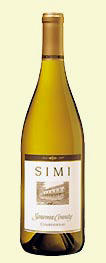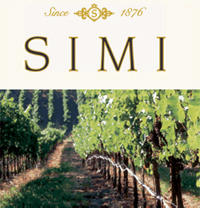Simi Winery's Glass One-Fifth Full Following TTAB Fracas
 California's Simi Winery found its glass four-fifths empty after its attempt to cancel (in five separate petitions) four registrations owned by Mr. Container for marks that include the word SIMI. In an exhausting 54-page decision, the Board granted the winery's Section 2(d) petition for cancellation of Respondent's registration for SIMI in stylized form (see below) for vinegar (and other food products), but it denied petitions for cancellation of SIMI for soft drink mix and bouillon cubes, SIMI DOCTOR for baking soda, and SIMI TI MOTO for seasoning. Simi Winery, Inc. v. Mr. Container, Cancellation No. 92030168 et al. (August 18, 2005) [not citable].
California's Simi Winery found its glass four-fifths empty after its attempt to cancel (in five separate petitions) four registrations owned by Mr. Container for marks that include the word SIMI. In an exhausting 54-page decision, the Board granted the winery's Section 2(d) petition for cancellation of Respondent's registration for SIMI in stylized form (see below) for vinegar (and other food products), but it denied petitions for cancellation of SIMI for soft drink mix and bouillon cubes, SIMI DOCTOR for baking soda, and SIMI TI MOTO for seasoning. Simi Winery, Inc. v. Mr. Container, Cancellation No. 92030168 et al. (August 18, 2005) [not citable].The winery relied on its ownership and prior use of the mark SIMI for wines, registered in 1973 and used since the late 1800s -- well before Respondent's first use dates. It also proved prior, albeit limited, use of the SIMI mark for vinegar and olive oil.
The Board began its du Pont analysis with a discussion of the fame of the SIMI mark for wine, again noting that, because of the dominant role that fame plays in that analysis, one who claims fame must "clearly prove it." The winery's annual sales of $23 to $34 million during the 1990s, and its annual advertising expenditures of $400,000 to $500,000 in the 1998-2004 time frame, were not impressive. Simi Winery has received some publicity through the years and may be "quite well known to people who appreciate fine wine," but its evidence was not enough support a finding of fame.
"Although wine connoisseurs may be well aware of the Simi Winery and the SIMI brand, the universe of wine purchasers in the United State is far larger than those who study wine guides or who are interested in reviews of the latest wine releases."
The Board did find, however, that SIMI "has achieved recognition as a mark for wine," that "any surname significance or geographic significance that might once have attached to the mark has long since disappeared," and that the record was devoid of evidence showing any third-party use. Thus SIMI must be considered a distinctive mark for wine, and the strength-of-the-mark factor favored the winery.
 The channels-of-trade factor slightly favored the winery, since wines and Registrant's goods may be found in grocery stores. The fact that they are rather inexpensive items also favored the winery. The actual confusion factor was neutral: there was no evidence of actual confusion, but then Registrant exports all its goods and thus there was no opportunity for confusion.
The channels-of-trade factor slightly favored the winery, since wines and Registrant's goods may be found in grocery stores. The fact that they are rather inexpensive items also favored the winery. The actual confusion factor was neutral: there was no evidence of actual confusion, but then Registrant exports all its goods and thus there was no opportunity for confusion.Turning to the particulars of the four registrations, the Board found that use of Respondent's stylized SIMI mark in connection with vinegar would be likely to cause confusion vis-a-vis the winery's SIMI mark for wine, as well as with its common law SIMI mark for wine vinegar. However, after the sweet taste of that first wine course, the next four bottles were sour.
As to SIMI for bouillon cubes, the Board could find no evidence linking wine and bouillon. With regard to SIMI for soft drink mix, the winery's evidence was "woefully lacking in terms of demonstrating that wine and powdered soft drink mix are related." And the registration for SIMI DOCTOR for baking soda survived because the winery "utterly failed to show that the parties' goods are related."
Finally, as to SIMI TI TOMO for seasoning (actually, MSG), the Board was "hard pressed to find that wine and seasonings are related." In any case, any such possible relatedness is "far outweighed" by the differences in the marks. The Board noted that this mark "presents a somewhat unusual situation," because it comprises words in two different "languages," Indonesian and Patois.
"Only a consumer who speaks both Indonesian and this Indonesian Patois is likely to understand the mark as meaning SIMI LITTLE SEASONING, and even this is somewhat questionable, since it is unclear whether such a consumer would realize that two words from different languages/dialects were being combined in a single mark."
Given the uncertainty as to how SIMI TI TOMO would be understood, the Board could not say that SIMI and SIMI TI MOTO convey the same connotations and commercial impressions. In any case, it appeared that the likelihood of confusion would be de minimis, since only "a very small number of consumers in the United States would be familiar with both the Indonesian language and the Patois dialect in which TI is a word."
Final Score: Mr. Container 4, Simi Winery 1.

TTABlog comment: Note that the Board, when considering the fame of the SIMI mark, followed this year's CAFC decision in Palm Bay Imports, Inc. v. Veuve Clicquot Ponsardin Maison Fondee En 1772, 73 USPQ2d 1689 (Fed. Cir. 2005). It looked not to the general public but to the universe of wine purchasers, in considering the fifth du Pont factor. [That universe has to be pretty close in size to the "general public"]. However, the Board did not focus on the much narrower universe of "wine connoisseurs," as noted above.
Text Copyright John L. Welch 2005.




0 Comments:
Post a Comment
<< Home